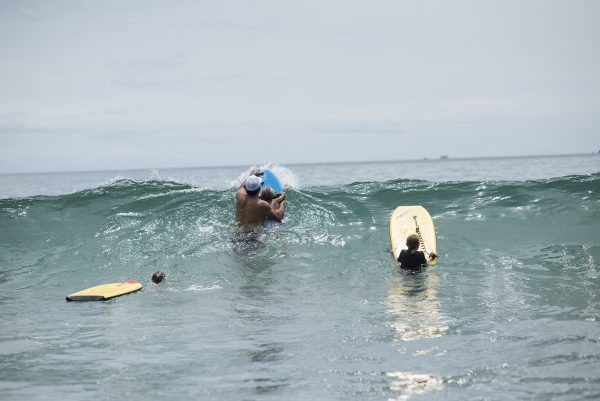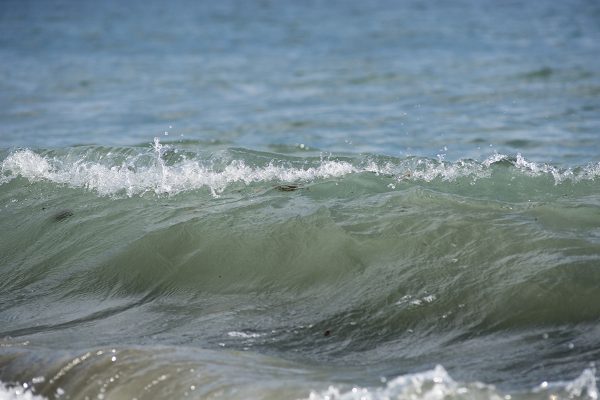Friday, November 9th, 2018.
Warm weather starting in the mid 70s and peaking in the low 80s today, with sun shining throughout the morning and a bit of cloud cover heading into the afternoon. Humidity is middling, around 75%, and expect light winds from the east that should pick up right for a few hours right before sunset. The tide will be coming in throughout most of the morning, with a high tide at 4pm, and the surf is expected to average between 2-3 feet, with some waves ranging up to around 5. Altogether a warm, pleasant day with blue skies and relaxed conditions.

The conditions are prime for body surfing today, as they are on most days in Las Catalinas, it's interesting to consider some of the science behind the sport.
According to Neville De Mestre, an Ironman world champion, Australian professor of mathematics, and foremost bodysurf scientist in the world, the sport comes down to a balance of forces. The rider's weight and body positioning provide both a downward and forward force, which keeps them sliding down the front of the wave. At the same time, the rider's buoyancy combines with the wave's forward and upward energy to provide both an upward and forward force on the rider. The upward and downward forces neutralize naturally through small adjustments up and down through the wave, and the resulting energy propels the rider forward.

However, this is easier said than done. According to the Guardian's in-depth interview with De Mestre --
"To bodysurf, you need to "climb" onto a wave when it is just about to break. Don't even think about trying to catch one that has already gone past. "Waves travel at three metres per second [3mps], and we can swim at about 2mps - and that's the speed of Ian Thorpe and the top swimmers in the world," says de Mestre. So you can either stand in the surf and push off as soon as the wave reaches the back of your legs, or you can swim out and wait in the break zone. If you're in the right position, you should be able to catch a wave with a single swimming stroke.
Timing is everything. Just in front of a wave's break point, and just behind, the forces in the crest of the wave are usually too small to propel a body along. "There is only a small window of opportunity available to use this generated force to build up the swimmer's speed to wave speed," says de Mestre. He has developed a formula for calculating the force that different swimmers must generate with their swimming stroke to succeed in getting them up to the speed of the wave. Someone who weighs 75kg and can swim at 1mps will need 160 newtons of force in the wave crest to reach wave speed, whereas someone who can swim at 2mps will need only 100 newtons. So, it's easier for a faster swimmer to catch a wave."
In simple terms, there are two parts to catching a wave -- timing the wave correctly to get in position just in front of the crest, and generating enough speed to let the wave pick you up, either via a push from the bottom or swimming strokes.

In Las Catalinas, the conditions are ideal for bodysurfing in that the bay has a very gentle slope off shore, which allows for a pair of benefits for the surfer. First, the shallow bottom means that surfers are able to stand up in the areas where the waves are breaking, giving a significantly better chance of catching a wave. Second, the long and slow break is ideal for longer rides, which are universally agreed upon by experts to be more fun. The bay in Las Catalinas also has waves that range from 1-5 feet, which is right in the ideal range for bodysurfing. Not too high as to be dangerous, but with enough energy to propel a bodysurfer.
Regarding specific techniques, De Mestre advises a streamlined position when bodysurfing, with both hands out front. This allows for better hydrodynamics and extra swimming strokes to stay on the wave. Though an avid purist of bodysurfing, De Mestre is also not slow to recommend the use of a body board for either beginning or intermediate surfers. By increasing the rider's buoyancy and reducing drag, a board changes the math such that not as much upward force is required to stay on top of the wave, and less forward force is required to catch the wave and stay riding. This combination of factors gives riders the opportunity to catch waves more easily, ride for longer, and catch smaller waves, at the cost of a loss of fine control.
Either way, as the expert says, the only way to improve is practice -- De Mestre has been practicing since the age of 8, and admits that he is still getting better each time he rides.